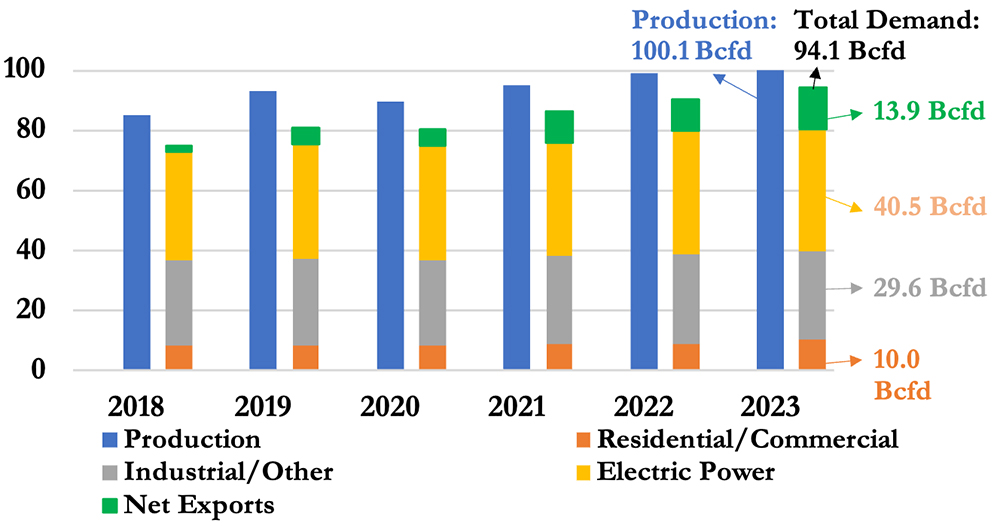Falling natural gas prices and the addition of electric resources are among the bright spots in FERC’s 2023 Summer Energy Market and Electric Reliability Assessment, FERC and NERC staff told the commission at its open meeting Thursday.
But the presenters also emphasized that tight margins in most of the continent could lead to problems with reliability in the event of hotter-than-expected weather conditions.
Presenting the assessment, James Burchill of FERC’s Office of Energy Policy and Innovation (OEPI) said that staff expect natural gas prices to be lower than last summer based on “record high natural gas production levels along with above-average natural gas storage inventories.” Gas production is expected to reach a record high of 100.1 Bcfd, up from last year’s forecast of 96.9 Bcfd, while demand is set to rise to 94.1 Bcfd from the 89.8 Bcfd predicted last year, 14% above the previous five-year average.

The electric power sector is expected to be the biggest domestic user of gas with 40.5 Bcfd, followed by the industrial sector at 29.6 Bcfd and residential/commercial at 10 Bcfd. These figures are largely in line with last year’s forecast. The increase primarily comes from net exports, including LNG and pipeline net exports, which are expected to average 13.9 Bcfd this summer, up 36.9% from summer 2022.
Despite burgeoning demand, FERC staff said that natural gas futures for June-September are significantly down at most trading hubs from their pre-summer levels last year, reflecting what OEPI’s Micah Gowen called “forecasts of greater availability of supply than last summer with a reduced need to inject natural gas into storage given above-average storage inventories.” Storage inventories ended the 2022-2023 withdrawal season at 1,830 Bcf, 32% higher than the start of the 2022 injection season and 22% above the five-year average.
One exception to this trend is California; the U.S. Energy Information Administration recorded natural gas storage levels at 74 Bcf by the end of the winter season in the Pacific region. The FERC report said a late summer heat wave last year reduced inventories, with the fall build unable to recover them to the same level. As a result of the low storage, California may experience “a tighter supply-demand balance and higher prices this summer as more supply will need to be routed into storage … than in a usual summer.”
Fears Continue over Electric Reliability
The FERC report came the day after NERC released its Summer Reliability Assessment, warning that most of the North American grid, including ERCOT, MISO, Ontario, New England, SPP, and parts of SERC and WECC, faces risk of supply shortfalls during “periods of more extreme summer conditions.” (See related story, NERC Warns of Summer Reliability Risks Across North America.) The National Weather Service has predicted that above-normal temperatures are likely across most of the continental U.S. and Alaska, while most of Canada is expected to see normal or below-normal temperatures.
 FERC Commissioner Mark Christie | © RTO Insider LLC
FERC Commissioner Mark Christie | © RTO Insider LLCNERC Manager of Reliability Assessments Mark Olson joined Thursday’s meeting to discuss the ERO’s assessment and its place in FERC’s summer forecast. He explained that the replacement of conventional generation with renewable energy resources has left some areas heavily reliant on weather-dependent resources such as wind and solar.
The ERO believes these generators are capable of meeting the needs of the grid in normal circumstances, but weather disturbances — particularly a drop in wind production — could cause multiple regions to turn to energy imports. If these issues affect multiple regions, utilities may not have neighbors to whom they can turn to ease the burden.
While acting FERC Chair Willie Phillips and Commissioner Allison Clements focused on the positive sides of the report — with Clements noting the renewal of California’s hydroelectric reservoirs — Commissioner Mark Christie reminded his colleagues that FERC and NERC assessments also show that concern is warranted. (See related story, Hydro, New Resources Boost CAISO’s Summer Outlook.)
“I take [the NERC report] as, ‘We hope we can get through the summer,’” Christie said. “We have a good chance: We have increased hydro in the West because the drought conditions have diminished. But the long-term trends, I don’t think [are] good news. … We hope we get all good news this summer. I hope so, and maybe we’ll get through the summer. But the long-term trends are still threatening, [and] we’ve got some major, major threats facing the reliability of the grid.”




